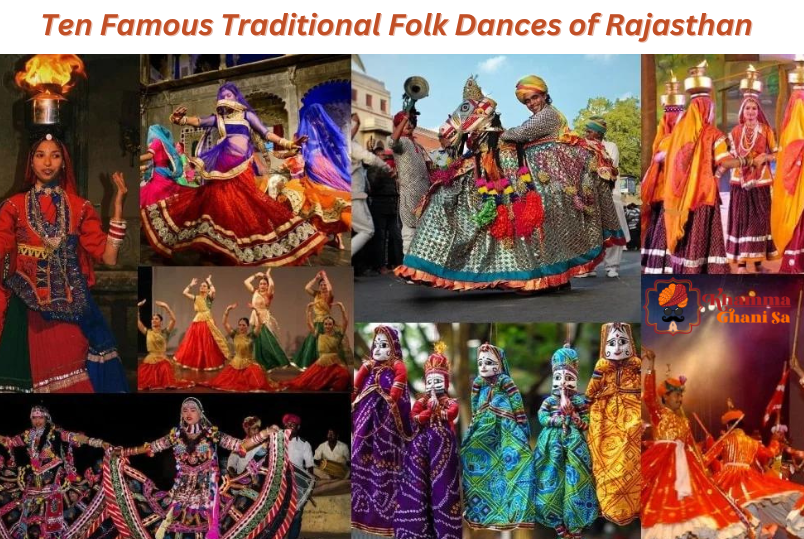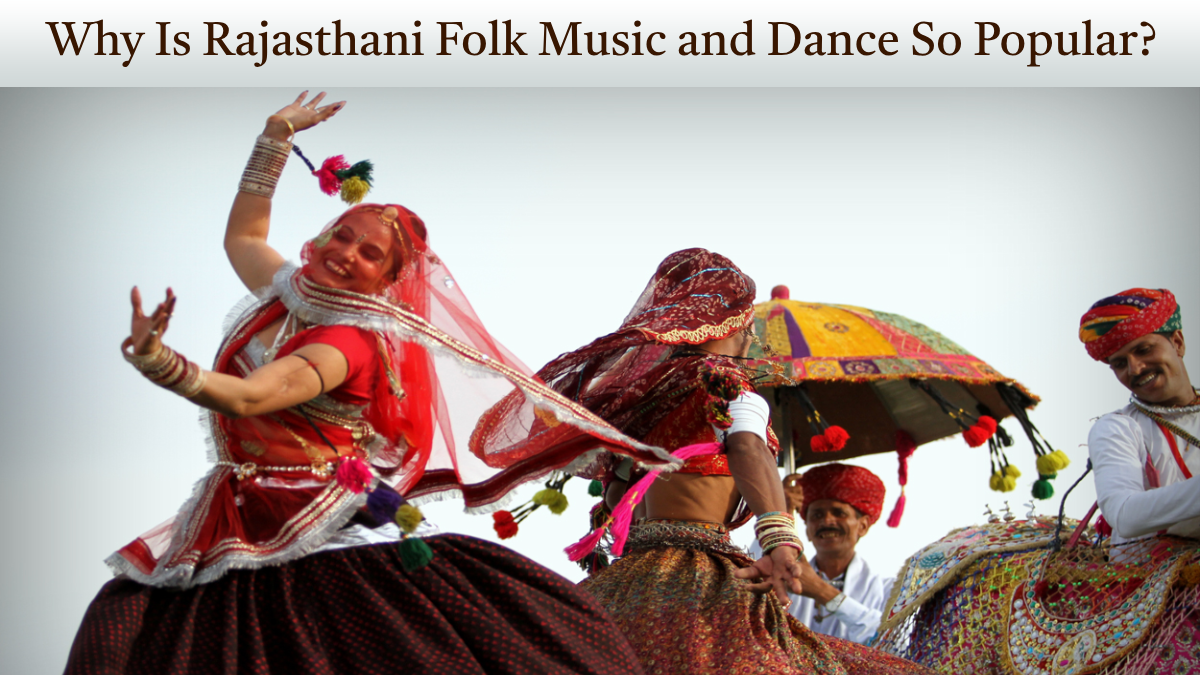Introduction,
Rajasthan, the land of vibrant colors and rich cultural heritage, is renowned for its diverse folk traditions, especially its energetic and beautiful dance forms. Every region boasts its unique style, reflecting the spirit of its people and their traditions.
Rajasthani folk dances are not just performances but vibrant expressions of the state’s culture and heritage. Here, we describe in detail about some of the top Rajasthani folk dances that allowing you to experience a slice of this incredible state’s soul.
Rajasthan’s most well-known folk dances:
- Ghoomar
- Kachchhi Ghodi
- Kalbelia Dance
- Bhavai Dance
- Fire Dance
- Chari Dance
- Kathputli Dance
- Gair Dance
- Teerah Taali/Taal
- Dhamal/Chang
- Ghoomar: Women Twirling in Circular Movements to Rhythmic Claps and Traditional Songs
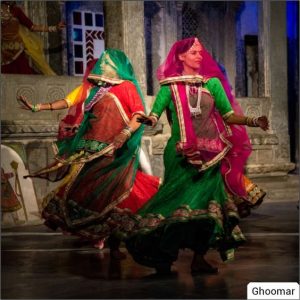
Ghoomar, Undoubtedly the most well-known Rajasthani dance form, originated among the Bhil community. It originated among the Bhil tribe but has since been adopted and popularized across Rajasthan. The name “Ghoomar” is derived from the Hindi word “ghoomna,” which means to spin around.
This dance form is primarily performed by women during auspicious occasions like weddings, festivals, and childbirth celebrations. It is characterized by graceful movements, where women in colorful attire spin gracefully in circles, often accompanied by traditional songs called ‘ghoomar geet.’
- Kachchhi Ghodi: Reviving Local Bandit Tales Through Mock Battles
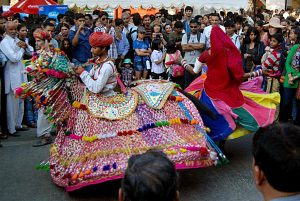
Kachchhi Ghodi, a vibrant Rajasthani folk dance, revives local tales of banditry through spirited mock fights and lively performances. This energetic dance form, where performers dress as horsemen and engage in mock skirmishes, celebrates valor and chivalry while entertaining audiences with its rhythmic beats and colorful spectacle, embodying Rajasthan’s folklore and cultural vibrancy.
In Kachchhi Ghodi, male performers dress as horsemen, wearing elaborate costumes that mimic the attire of grooms during traditional weddings. They ride dummy horses made of cloth and dance energetically to the rhythm of folk music played on instruments like the dholak and harmonium.
- Kalbelia Dance: Recognized as UNESCO’s Intangible Cultural Heritage
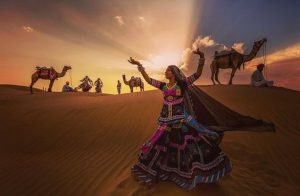
The Kalbelia dance, also known as the “Sapera Dance,” is a captivating performance by the Kalbelia tribe. The Kalbelia dance is not just a performance but a cultural expression deeply rooted in the community’s connection with nature and spirituality. Kalbelia women dancers wear long black skirts embellished with silver thread, reflecting the scales of snakes and odhnis.
The accompanying music features instruments like the pungi (snake charmer’s pipe), dholak (drum), and khanjari (frame drum), creating a lively and captivating soundscape. The Kalbelia dance is a powerful symbol of Rajasthan’s vibrant cultural heritage.
- Bhavai Dance: A Ritualistic Dance of Balancing and Rhythmic Acts
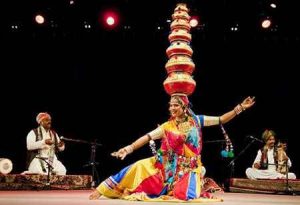
Bhavai is a mesmerizing folk dance form with a touch of acrobatics. Performed by women from communities like the Kalbelia, Jat, and Bhil, it involves balancing a precarious stack of eight to nine brass pitchers or earthen pots on their heads while gracefully twirling and dancing on the edge of a brass plate or a glass surface.
The dance involves intricate footwork, graceful hand gestures, and a display of balance and precision that captivates audiences. Bhavai dance is not only a visual spectacle but also a testament to the resilience and artistry of Rajasthan’s rural communities. Bhavai dance is one of the most challenging dance forms. So for this, you have to choose the right rajasthani folk group for your wedding or any kind of cultural program.
- Fire Dance: Daring Display of Bravery and Skill Performance
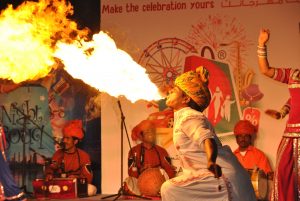
Fire Dance, as the name suggests, is a daring display of bravery and skill. Performers dance on a bed of flaming coals, barefoot and seemingly unharmed by the intense heat. Originating from the tribal communities of Rajasthan, the dance involves men and women dancing with fire torches, twirling them around their bodies and manipulating them with impressive skill.
- Chari Dance: Celebration of Life, Hope, and the Blessings of Nature
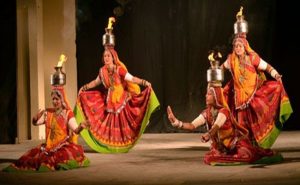
The Chari Dance, also known as the “Matki Dance,” is a graceful performance by women during festivals and auspicious occasions. During Chari Dance, women carry a lighted lamp or ‘diya’ inside the chari (pot) on their heads. They move gracefully, often in a group, performing synchronized steps and gestures to the beat of folk music.
The dance’s visual appeal, coupled with its cultural symbolism, makes it an integral part of Rajasthan’s folk heritage. It is often performed during festivals like Diwali and Holi.
- Kathputli Dance: Wooden Puppets to Enact Tales of Rajasthani Folklore
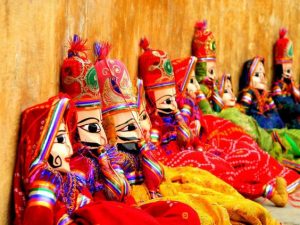
In the vibrant tapestry of Rajasthani folk dances, the Kathputli Dance stands out as a unique and captivating art form. It’s not a dance by humans themselves, but rather a mesmerizing display of storytelling through the art of puppetry.
Kathputli or puppet dance is a unique form where skilled puppeteers manipulate traditional wooden puppets to enact tales of Rajasthani folklore. These colorful puppets come to life with intricate movements synchronized to folk songs and music.
- Gair Dance: The Dance Reflects the Community’s Unity and Spirit
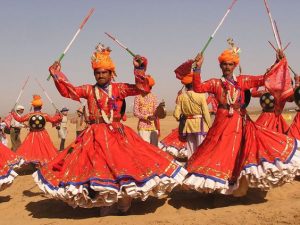
Gair is a traditional dance performed by the Bhil community during festivals like Holi and Janmashtami. Men form concentric circles and dance in a rhythmic pattern, They move in circles, clockwise and anti-clockwise, their synchronized steps and joyous expressions reflecting the spirit of celebration.
Through its vibrant performances, symbolic gestures, and rhythmic melodies, Gair Dance continues to captivate audiences and uphold traditions that celebrate unity, joy, and the enduring spirit of Rajasthan’s diverse communities.
- Teerah Taali/Taal: Dance Characterized by its Rhythmic Claps and Storytelling Nature
The name perfectly captures the essence of the dance, which revolves around a specific sequence of thirteen claps/beats. These beats create a rhythmic foundation for the dance, accompanied by the movements of the performers and the captivating melodies of traditional instruments.
The dance is dedicated to the folk deity Baba Ramdevji and is believed to invoke blessings and ward off evil spirits. The synchronized clapping creates a mesmerizing rhythm that defines the essence of this spiritual dance.
- Dhamal/Chang: High Energy Celebration by Men with Spins and Clapping
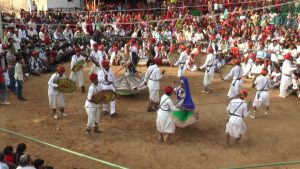
Dhamal or Chang is a lively dance performed, known for their vibrant culture and rhythmic dances. It involves quick footwork and energetic movements, often accompanied by the beats of the ‘chang’ (a musical instrument). Dhamal is a celebration of life and community bonds, echoing through the sandy dunes of Rajasthan.
Dhamal/Chang is more than just a dance; it’s a celebration of community spirit. Often performed during festivals like Holi and Diwali, it brings people together in a joyous display of unity and enthusiasm.
In the end,
These ten Rajasthani folk dances not only entertain but also serve as repositories of cultural heritage. They reflect the spirit, traditions, and history of the people who have inhabited Rajasthan for centuries. These dances continues to captivate audiences and uphold traditions that celebrate unity, joy, and the enduring spirit of Rajasthan’s diverse communities and that’s why rajasthani folk music and dance so popular.
These Dances is more than just entertainment; it’s a window into Rajasthan’s rich cultural heritage. The stories enacted by these dance forms keep traditions alive, passing down folklore, mythology, and social values from generation to generation.
So, next time you find yourself in Rajasthan, be sure to seek out a folk dance performance and immerse yourself in the vibrant tapestry of this incredible state.

